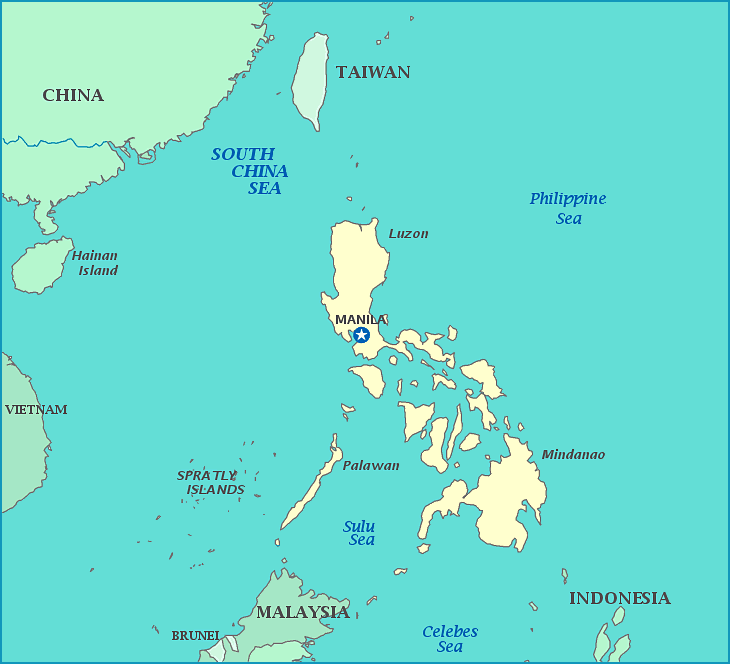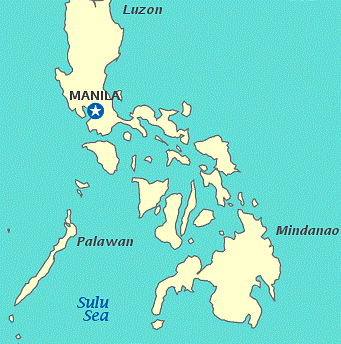
"If you break our rules,
we will kill you
or we will do something worse."
They did something worse.
Puerto Princesa Prison, Palawan Philippines
Within days of the December 7, 1941 attack on Pearl Harbor, the Empire of Japan bombed the Philippines (a Spanish possession for three hundred years until America defeated Spain in the Spanish-American War). These actions against the Philippines, and those that followed, led to disaster for thousands of American and Filipino forces stationed in the country.
The Americans captured in the Philippines were initially detained in filthy, overcrowded POW camps near Manila, but eventually most were shipped to other parts of the Japanese empire as slave laborers.
American prisoners remaining in the Philippines were 346 men who were sent 350 miles on August 1, 1942, from the Cabanatuan POW camps north of Manila, and from Bilibid Prison in Manila itself, to Puerto Princesa on the island of Palawan.

Palawan is on the western perimeter of the Sulu Sea, and the POWs were shipped there to build an airfield for their captors. Although the prisoners' numbers fluctuated throughout the war, the brutal treatment they received at the hands of their Japanese guards was always the same. The men were beaten with pick handles, and kickings and slappings were regular daily occurrences. Prisoners who attempted to escape were summarily executed.
At the Palawan compound food was minimal; each day, prisoners received a mess kit of wormy Cambodian rice and a canteen cup of soup made from camote vines boiled in water (camotes are a Philippine variant of sweet potatoes). Prisoners who could not work had their rations cut by 30 percent. If POWs were caught stealing food, they were whipped and beaten unconscious and revived to undergo further beatings. When American POWs were caught taking green papayas from a tree in the compound, their left arms were broken with an iron bar.
On September 1944, 159 of the American POWs at Palawan were returned to Manila. The remaining 150 men could complete the arduous labor on the airfield (1,530 yards long and 75 yards wide), hauling and crushing coral gravel by hand and pouring concrete seven days a week.
As American bombers and liberators sank ships and damaged planes at Palawan, POW morale in the camp soared. But the treatment by the Japanese grew worse and their rations were cut. The Japanese reluctantly allowed the Americans to paint American Prisoner of War Camp on the roof of their barracks. This gave the prisoners some measure of protection from American air attacks. The Japanese then stowed their own supplies under the POW barracks.
The constant presence of Allied aircraft overhead caused the prisoners to construct three shelters, each 150 feet long and 4 feet high, for their own protection during air raids. The Japanese had ordered that the entrances at each end of the shelters be only large enough to admit one man at a time. The shelters were roofed with logs and dirt and were located on the beach side of the camp.
On December 14, Japanese aircraft reported the presence of an American convoy, which they thought was destined for Palawan. All prisoner work details were recalled to the camp at noon. Two American Lockheed P-38 Lightning fighter aircraft were sighted, and the POWs were ordered into the air raid shelters. After a short time the prisoners re-emerged from their shelters, but Japanese 1st Lt. Yoshikazu Sato, whom the prisoners called the Buzzard, ordered them to stay in the area. A second alarm at 2 p.m. sent the prisoners back into the shelters, where they remained, closely guarded.
Suddenly, in an orchestrated and obviously planned move, 50 to 60 Japanese soldiers under Sato's leadership doused the wooden shelters with buckets of gasoline and set them afire with flaming torches, followed by hand grenades. The screams of the trapped and doomed prisoners mingled with the cheers of the Japanese soldiers and the laughter of their officer, Sato. As men engulfed in flames broke out of their fiery deathtraps, the Japanese guards machine gunned, bayoneted and clubbed them to death. Most of the Americans never made it out of the trenches and the compound before they were barbarously murdered, but several closed with their tormentors in hand-to-hand combat and succeeded in killing a few of the Japanese attackers.
A Marine survivor described escaping from his shelter as coming up a ladder into Hell. The four American officers in the camp had their own dugout, which the Japanese also doused with gasoline and torched. One officer, his clothes on fire, ran toward the Japanese and pleaded with them to use some sense but was machine-gunned to death.
About 30 to 40 Americans escaped from the massacre area, either through the double-woven, 61ž2-foot-high barbed-wire fence or under it, where some secret escape routes had been concealed for use in an emergency. They fell and/or jumped down the cliff above the beach area, seeking hiding places among the rocks and foliage. Several attempted to swim across Puerto Princesa's bay immediately, but were shot in the water. The continuing butchery could still be heard going on above. The Japanese were even using dynamite in forcing some of the men from their shelters. The stench of burning flesh was strong and the Japanese began moving in groups among the rocks dragging the Americans out and murdering them as they found them.
The slaughter continued until dark. Some of the wounded Americans were buried alive by the Japanese. Men who attempted to swim to safety across the bay were shot by soldiers on the shore or on a Japanese landing barge. A witness saw a party of five or six Japanese with an American who had been wounded, poking him along with bayonets that was drawing blood. Another Jap came up with some gasoline and a torch, and the American begged them to shoot him and not to burn him. The Japanese threw some gasoline on his foot and lit it, and the other Japanese laughed and poked him with their bayonets. Then they did the same thing to his other foot and to his hand. When the man collapsed, the Japanese then threw the whole bucket of gasoline over him, and he burst into flames.
When the Japanese ended their search for the surviving prisoners, there were still a few undiscovered Americans alive. Several prisoners hid in a sewer outlet. When the Japanese shone lights into the pipe, the POWs ducked under the water and were not discovered. After nightfall, they attempted to swim the bay, which was 5 miles across at that point. Of the 146 enlisted men and four officers held in the Palawan prison camp, only 11 men survived the massacre on December 14, 1944. Most of the survivors swam across the bay and were rescued by the inmates of Palawan's Iwahig Penal Colony, where several of the officials in charge were involved with the local resistance movement.
Filipino civilian prisoners at the colony, who were interned during the Japanese occupation of their homeland, fed and clothed the American POWs and contacted local guerrilla leaders on their behalf. The guerrillas escorted the Americans down the coast to Brooke's Point, where they were evacuated by a U.S. Navy seaplane to Leyte. There they told their story to U.S. military authorities.
Those who suffered at the hands of the Japanese government, like the POWs of Palawan, received some retribution at the War Crime Trials held in Manila and Tokyo after the end of World War II. Altogether, 5,000 Japanese were arrested for individual acts of brutality which had taken the lives of over a half million people from Asia and the United States. About 4,000 Japanese were brought to trial. Of the 4,000, 800 were acquitted, 2,400 were sentenced to three years or more in prison, and 809 were executed.
MAY THEY NEVER BE FORGOTTEN
Palawan Massacre Memorial
Commemorative Research Project - Pictorial Archive
Bataan Death March - The Great Raid

No comments:
Post a Comment